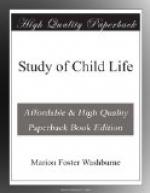STUDY OF CHILD LIFE
PART I.
The young of the human species is less able to care for itself than the young of any other species. Most other creatures are able to walk, or at any rate stand, within a few hours of birth. But the human baby is absolutely dependent and helpless, unable even to manufacture all the animal heat that he requires. The study of his condition at birth at once suggests a number of practical procedures, some of them quite at variance with the traditional procedures.
HOW THE CHILD DEVELOPS
[Sidenote: Condition at Birth]
Let us see, then, exactly what his condition is. In the first place, he is, as Virchow, an authority on physiological subjects declares, merely a spinal animal. Some of the higher brain centers do not yet exist at all, while others are in too incomplete a state for service. The various sensations which the baby experiences—heat, light, contact, motion, etc.—are so many stimuli to the development of these centers. If the stimulus is too great, the development is sometimes unduly hastened, with serious results, which show themselves chiefly in later life. The child who is brought up a noisy room, is constantly talked to and fondled, is likely to develop prematurely, to talk and walk at an early age; also to fall into nervous decay at an early age. And even if by reason of an unusually good heredity he escapes these dangers, it is almost certain that his intellectual power is not so great in adult life as it would have been under more favorable conditions. A new baby, like a young plant, requires darkness and quiet for the most part. As he grows older, and shows a spontaneous interest in his surroundings, he may fittingly have more light, more companionship, and experience more sensations.
[Sidenote: Weight at Birth]
The average boy baby weighs about seven pounds at birth; the average girl, about six and a half pounds. The head is larger in proportion to the body than in after life; the nose is incomplete, the legs short and bowed, with a tendency to fall back upon the body with the knees flexed. This natural tendency should be allowed full play, for the flexed position is said to be favorable to the growth of the bones, permitting the cartilaginous ends of the bones to lie free from pressure at the joints.
The plates of the skull are not complete and do not fit together at the edges. Great care needs to be taken of the soft spot thus left exposed on the top of the head—the undeveloped place where the edges of these bones come together. Any injury here in early life is liable to affect the mind.
[Sidenote: State of Development]




